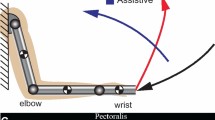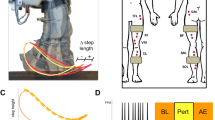Abstract
Impedance modulation has been suggested as a means to suppress the effects of internal ‘noise’ on movement kinematics. We investigated this hypothesis in a neuro-musculo-skeletal model. A prerequisite is that the muscle model produces realistic force variability. We found that standard Hill-type models do not predict realistic force variability in response to variability in stimulation. In contrast, a combined motor-unit pool model and a pool of parallel Hill-type motor units did produce realistic force variability as a function of target force, largely independent of how the force was transduced to the tendon. To test the main hypothesis, two versions of the latter model were simulated as an antagonistic muscle pair, controlling the position of a frictionless hinge joint, with a distal segment having realistic inertia relative to the muscle strength. Increasing the impedance through co-activation resulted in less kinematic variability, except for the lowest levels of co-activation. Model behavior in this region was affected by the noise amplitude and the inertial properties of the model. Our simulations support the idea that muscular co-activation is in principle an effective strategy to meet accuracy demands.
Similar content being viewed by others
References
Adam A, DeLuca CJ, Erim Z (1998) Hand dominance and motor unit firing behavior. J Neurophysiol 80(3):1373–1382
Burdet E, Osu R, Franklin DW, Milner TE, Kawato M (2001) The central nervous system stabilizes unstable dynamics by learning optimal impedance. Nature 414(6862):446–449
Christou EA, Grossman M, Carlton LG (2002) Modeling variability of force during isometric contractions of the quadriceps femoris. J Mot Behav 34(1):67–81
Franklin DW, Burdet E, Osu R, Kawato M, Milner TE (2003) Functional significance of stiffness in adaptation of multijoint arm movements to stable and unstable dynamics. Exp Brain Res 151(2):145–157
Fuglevand AJ, Winter DA, Patla AE (1993) Models of recruitment and rate coding organization in motor-unit pools. JNeurophysiol 70(6):2470–2488
Gribble PL, Mullin LI, Cothros N, Mattar A (2003) A role for cocontraction in arm movement accuracy. J Neurophysiol 89(5):2396–2405
Hamilton AF, Wolpert DM (2002) Controlling the statistics of action: obstacle avoidance. J Neurophysiol 87(5):2434–2440
Harris CM, Wolpert DM (1998) Signal-dependent noise determines motor planning. Nature 394(6695):780–784
Jones KE, De AF, Hamilton C, Wolpert DM (2002) Sources of signal-dependent noise during isometric force production. J Neurophysiol 88(3):1533–1544
Laidlaw DH, Bilodeau M, Enoka RM (2000) Steadiness is reduced and motor unit discharge is more variable in old adults. Muscle Nerve 23(4):600–612
Laursen B, Jensen BR, Sjogaard G (1998) Effect of speed and precision demands on human shoulder muscle electromyography during a repetitive task. Eur J Appl Physiol Occup Physiol 78(6):544–548
Matthews PB (1996) Relationship of firing intervals of human motor units to the trajectory of post-spike after-hyperpolarization and synaptic noise. J Physiol 492(Pt2):597–628
Mazzaro N, Grey MJ, Sinkjaer T (2005) Contribution of afferent feedback to the soleus muscle activity during human locomotion. J Neurophysiol 93(1):167–177
McAuley JH, Rothwell JC, Marsden CD (1997) Frequency peaks of tremor, muscle vibration and electromyographic activity at 10 hz, 20 hz and 40 hz during human finger muscle contraction may reflect rhythmicities of central neural firing. Exp Brain Res 114(3):525–541
Moritz CT, Barry BK, Pascoe MA, Enoka RM (2005) Discharge rate variability influences the variation in force fluctuations across the working range of a hand muscle. JNeurophysiol 93(5):2449–2459
Osu R, Gomi H (1999) Multijoint muscle regulation mechanisms examined by measured human arm stiffness and emg signals. J Neurophysiol 81(4):1458–1468
Osu R, Kamimura N, Iwasaki H, Nakano E, Harris CM, Wada Y, Kawato M (2004) Optimal impedance control for task achievement in the presence of signal-dependent noise. JNeurophysiol 92(2):1199–1215
Pandy MG, Zajac FE, Sim E, Levine WS (1990) An optimal control model for maximum-height human jumping. J Biomech 23(12):1185–1198
Perreault EJ, Kirsch RF, Acosta AM (1999) Multiple-input, multiple-output system identification for characterization of limb stiffness dynamics. Biol Cybern 80(5):327–337
Ridderikhoff A, Peper CL, Carson RG, Beek PJ (2004) Effector dynamics of rhythmic wrist activity and its implications for (modeling) bimanual coordination. Hum Mov Sci 23(3-4):285–313
Scholz JP, Schöner G, Latash ML (2000) Identifying the control structure of multijoint coordination during pistol shooting. Exp Brain Res 135(3):382–404
Shiller DM, Laboissiere R, Ostry DJ (2002) Relationship between jaw stiffness and kinematic variability in speech. J Neurophysiol 88(5):2329–2340
Slifkin AB, Newell KM (1999) Noise, information transmission, and force variability. J Exp Psychol Hum Percept Perform 25(3):837–851
Taylor AM, Christou EA, Enoka RM (2003) Multiple features of motor-unit activity influence force fluctuations during isometric contractions. J Neurophysiol 90(2):1350–1361
Todorov E, Jordan MI (2002) Optimal feedback control as a theory of motor coordination. Nat Neurosci 5(11):1226–1235
Tseng YW, Scholz JP, Schöner G, Hotchkiss L (2003) Effect of accuracy constraint on joint coordination during pointing movements. Exp Brain Res 149(3):276–288
Vander Burg JCE, Casius LJR, Kingma I, VanDieén JH, VanSoest AJ (2005) Factors underlying the perturbation resistance of the trunk in the first part of a lifting movement. Biol Cybern 93(1):54–62
VanGalen GP, DeJong W (1995) Fitts’ law as the outcome of a dynamic noise filtering model of motor control. Hum Mov Sci 12:539–571
VanSoest AJ, Bobbert MF (1993) The contribution of muscle properties in the control of explosive movements. Biol Cybern 69(3):195– 204
Visser B, DeLooze M, DeGraaff M, VanDieén J (2004) Effects of precision demands and mental pressure on muscle activation and hand forces in computer mouse tasks. Ergonomics 47(2):202–217
Wagner H, Blickhan R (2003) Stabilizing function of antagonistic neuromusculoskeletal systems: an analytical investigation. Biol Cybern 89(1):71–79
Welter TG, Bobbert MF (2002) Initial arm muscle activation in a planar ballistic arm movement with varying external force directions: a simulation study. Motor Control 6(3):217–229
Author information
Authors and Affiliations
Corresponding author
Rights and permissions
About this article
Cite this article
Selen, L.P.J., Beek, P.J. & Dieën, J.H.v. Can co-activation reduce kinematic variability? A simulation study. Biol Cybern 93, 373–381 (2005). https://doi.org/10.1007/s00422-005-0015-y
Received:
Accepted:
Published:
Issue Date:
DOI: https://doi.org/10.1007/s00422-005-0015-y




